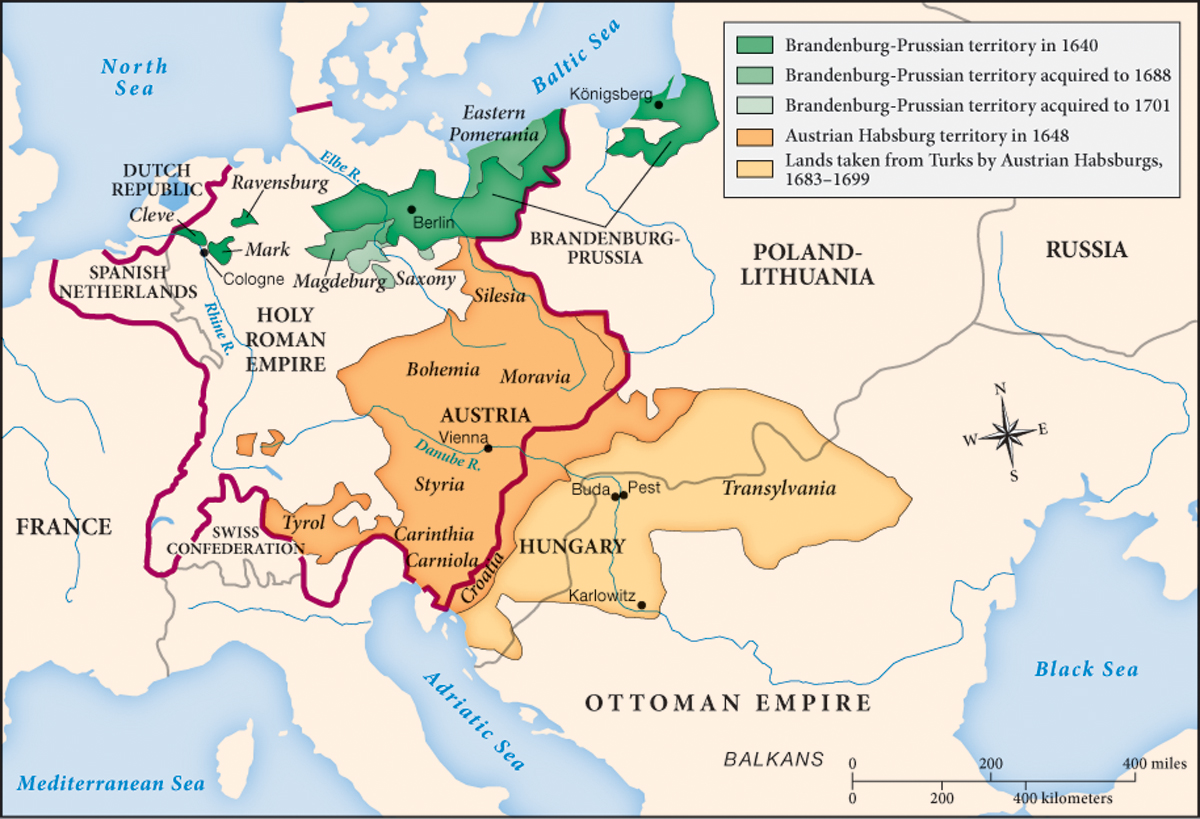An Uneasy Balance: Austrian Habsburgs and Ottoman Turks
Printed Page 526
Important EventsAn Uneasy Balance: Austrian Habsburgs and Ottoman Turks
Holy Roman Emperor Leopold I (r. 1658–1705) ruled over a variety of territories of different ethnicities, languages, and religions, yet in ways similar to his French and Prussian counterparts, he gradually consolidated his power. Like all other Holy Roman Emperors since 1438, Leopold was an Austrian Habsburg. He was simultaneously duke of Upper and Lower Silesia, count of Tyrol, archduke of Upper and Lower Austria, king of Bohemia, king of Hungary and Croatia, and ruler of Styria and Moravia (Map 16.3). Some of these territories were provinces in the Holy Roman Empire; others were simply ruled from Vienna as Habsburg family holdings.

In response to the weakening of the Holy Roman Empire by the ravages of the Thirty Years’ War, the emperor and his closest officials took control over recruiting, provisioning, and strategic planning and worked to replace the mercenaries hired during the war with a permanent standing army that promoted professional discipline. Intent on replacing Bohemian nobles who had supported the 1618 revolt against Austrian authority, the Habsburgs promoted a new nobility made up of Czechs, Germans, Italians, Spaniards, and even Irish who used German as their common tongue, professed Catholicism, and loyally served the Austrian dynasty. Bohemia became a virtual Austrian colony. In addition to holding Louis XIV in check on his western frontiers, Leopold confronted the ever-present challenge of the Ottoman Turks to the east. Austria had fought the Turks for control of Hungary for more than 150 years. In 1682, war broke out again. As they had in 1529, the Turks in 1683 pushed all the way to the gates of Vienna and laid siege to the Austrian capital. With the help of Polish cavalry, the Austrians finally broke the siege and turned the tide in a major counteroffensive. By the Treaty of Karlowitz of 1699, the Ottoman Turks surrendered almost all of Hungary to the Austrians, marking the beginning of the decline of Ottoman power.
Once the Turks had been beaten back, Austrian rule over Hungary tightened. In 1687, the Habsburg dynasty’s hereditary right to the Hungarian crown was acknowledged by the Hungarian diet, a parliament revived by Leopold in 1681 to gain the cooperation of Hungarian nobles. The diet was dominated by a core of pro-Habsburg Hungarian aristocrats, who would support the dynasty until it fell in 1918. To root out remaining Turkish influence and assert Austrian superiority, Leopold systematically destroyed Turkish buildings and rebuilt Catholic churches, monasteries, roadside shrines, and monuments in the flamboyant Austrian baroque style.
The Ottoman Turks pursued their state consolidation in a different fashion. Hundreds of thousands of Turkish families had moved with Turkish soldiers into the Balkan peninsula in the 1400s and 1500s. As locals converted to Islam, administration passed gradually into their hands. The Ottoman state, ultimately, would last longer than the French absolutist monarchy, even though the Ottoman rulers, the sultans, were often challenged by mutinous army officers. Despite frequent palace coups and assassinations of sultans, the Ottoman state continued to pose a massive military threat on Europe’s southeastern borders.